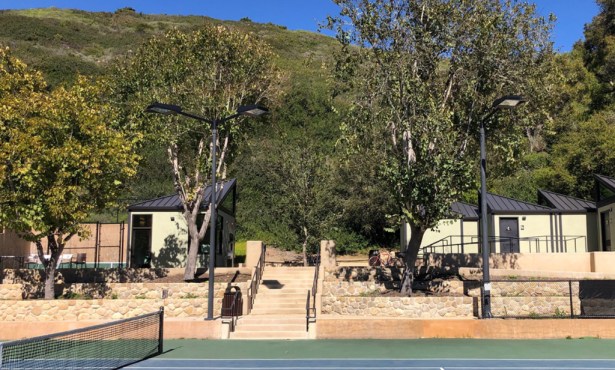What’s in a Name?
by Gerald Carpenter
GETTING THE NOD: The Camerata Pacifica will
open its season of chamber music concerts on Friday, September 15,
in Santa Barbara, with a program of certified masterpieces: Ludwig
Beethoven’s Violin Sonata No. 9 in A Major, Opus 47 “Kreutzer,”
performed by violinist Catherine Leonard and pianist Warren Jones;
Sergei Rachmaninoff’s Sonata for Cello and Piano in G Minor, Opus
19, with cellist Ani Aznavoorian and pianist Robert Thies; and
concluding with Franz Schubert’s Piano Trio in E-flat Major, Opus
100, D. 929, played by Jones, Leonard, and Aznavoorian. With these
artists and these works, the Camerata is obviously leading
trumps.
There will be a lunchtime performance of the Schubert at 1 p.m.,
and the full program will be performed at 8 p.m., both concerts
taking place in the Camerata’s new venue, the exquisite Lehmann
Hall in the main building of the Music Academy of the West. For
tickets and other information, call 884-8410 or visit them online
at cameratapacifica.org.
The so-called Kreutzer Sonata gets its name from one Rodolphe
Kreutzer, a contemporary (1778-1832) of Beethoven and one of the
most celebrated violinists of the age. The sonata is dedicated to
him. Despite his name, Kreutzer was French, born at Versailles and
died in Geneva. According to an article about him in Grove’s
Dictionary, “Kreutzer did not require Beethoven’s dedication to
make his name immortal.” The writer’s statement is based on the
fact that, in his time, Kreutzer was famous not only for his
virtuosity but for his numerous compositions, and for founding and
promulgating one of the dominant schools of violin playing.
Still, I rather doubt that, outside the somewhat limited circles
of musicologists and pedagogues, Kreutzer’s name would, in fact, be
all that immortal if Beethoven hadn’t slapped it on his greatest
violin sonata in a rage at the original dedicatee. Because the
funny part of the story is that Kreutzer never played the work, and
considered it, in his judgment, “unplayable.”
The sonata was first performed in 1802, by the Polish-West
Indian violinist George Bridgetower (1779–1860), with Beethoven
himself at the piano. Bridgetower’s father was a black West Indian
who was employed by Haydn’s patrons, the Princes Esterházy. He was
a child prodigy, and on a visit to England, the Prince of Wales,
the future George IV, became his legal guardian. On a tour of
Hapsburg lands, he met Beethoven, who befriended him. Although the
sonata was a great success when premiered, the friendship did not
last. Bridgetower and Beethoven got drunk together a week after the
concert. The violinist made a disparaging remark about a lady who
was a close friend of the composer, and that was that. (Around the
same time, Napoleon crowned himself emperor and Beethoven changed
the name of his Third Symphony from “Bonaparte” to “Eroica,” so
maybe that was a brief trend with him.)
Thanks to Beethoven, Kreutzer’s name also lives on in the title
of a Tolstoy short story, “The Kreutzer Sonata” (1889), in which
the narrator’s wife, a pianist, plays the sonata with a handsome
violinist, and plays it so passionately that the narrator is
convinced they are having an affair and kills her. And, finally,
the Czech composer Leosˇ Janácˇek (1854-1928), inspired to renewed
creativity by an extramarital affair, named his first string
quartet The Kreutzer Sonata in honor of the Tolstoy story.
Coming this Saturday, September 16, the Santa Barbara Master
Chorale will put on an event called The Val Verde Affair, a benefit
fundraiser for the chorale at the historic Val Verde Estate.
Described as “an afternoon of dance; live music of the ’20s, ’30s,
and ’40s; great hors d’oeuvres; and silent auction,” the Affair is
by invitation only, so for information on getting invited, call
967-8287.


